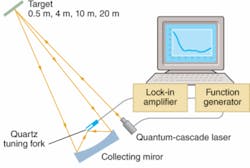OPTICAL SENSING: Laser-acoustic device detects explosives residue from a safe distance

The ability to detect explosives remotely may soon be possible using “standoff” photoacoustic spectroscopy, say scientists at Oak Ridge National Laboratory (ORNL; Oak Ridge, TN). Together with researchers at the University of Tennessee (Knoxville, TN), ORNL engineer Charles Van Neste demonstrated a laser device using a variation of photoacoustic spectroscopy (PAS) to detect chemical traces of explosives at distances up to 20 m, which could improve the safety of troops in dangerous conditions. Whereas some remote-detection techniques send the sensor near the sample while the operator remains at a safe distance, standoff detection means that both the operator and the detector are a safe distance from the target.1
Photoacoustic spectroscopy is a technique demonstrated in the late 1880s that generates acoustic waves via the photoelectric effect upon illumination of a sample. The technique, which can be used to investigate the optical properties of the target, has advantages over simple optical spectroscopy, such as enabling the measurement of nonradiative transitions, high signal-to-noise ratio, and the ability to probe transparent or opaque media.
Laser and tuning fork
Unfortunately, standoff detection of an open-air sample—preferred over remote detection for material analysis in commercial applications—using PAS is difficult because the intensity of the acoustic waves reduces considerably in magnitude as a function of air disturbances and increasing distance from the sample. To overcome these obstacles, the new method relies on a 100 mW quantum-cascade laser from Daylight Solutions (Poway, CA) and a tuning fork, rather than the traditional microphone.
Testing of the ORNL version of PAS involved coating a steel surface with test chemicals and residues of explosives, namely trinitrotoluene (TNT), tributyl phosphate (TBP), cyclotrimethylenetrinitromine (RDX), and pentaerythritol tetranitrate (PETN). The target was illuminated with the quantum-cascade laser, which was placed anywhere from 0.5 to 20 m away, and which emitted pulsed light at a 9.5 μm wavelength (see figure). The scattered and backreflected light was then focused by a collecting mirror onto a quartz-crystal tuning fork, which offered frequency sensitivity on the order of 0.1 Hz. The tuning fork also offered a high Q factor of 10,000 in air—a distinct advantage over other types of optical detectors.
The resulting acoustic wavelength spectra revealed IR absorption by surface concentrations of only 100 ng/cm2. The QCL power of 100 mW with a duty cycle of 5% is 100 times less powerful than that required by competing technologies, according to ORNL. However, in the future, the group may increase the power of the laser to increase the distance at which the technique is useful. The group is also planning to further improve the technique using larger focusing mirrors. Use of a QCL with a wider tuning range or of several tunable QCLs in tandem will produce a broader optical spectra, and possibly enable detection of dangerous sources of explosions at distances of up to 100 m.
Even for standoff distances of 10 to 20 m (which did require amplification of the tuning-fork signal), reproducible and identifiable spectra were obtained for surface concentrations of explosives as low as 100 ng/cm2. “In today’s political climate, the ability to interrogate suspicious objects at a safe distance is of increasing importance to national security,” says ORNL researcher Larry Senesac. “As we increase the wavelength range and the operational standoff detection distance of the technique, we plan to build a portable device capable of detecting roadside improvised explosive devices as well as scanning luggage, cargo, and mail for explosive compounds.”
REFERENCE
1. C.W. Van Neste et al., Appl. Phys. Lett. 92, 234102 (2008).
About the Author
Valerie Coffey-Rosich
Contributing Editor
Valerie Coffey-Rosich is a freelance science and technology writer and editor and a contributing editor for Laser Focus World; she previously served as an Associate Technical Editor (2000-2003) and a Senior Technical Editor (2007-2008) for Laser Focus World.
Valerie holds a BS in physics from the University of Nevada, Reno, and an MA in astronomy from Boston University. She specializes in editing and writing about optics, photonics, astronomy, and physics in academic, reference, and business-to-business publications. In addition to Laser Focus World, her work has appeared online and in print for clients such as the American Institute of Physics, American Heritage Dictionary, BioPhotonics, Encyclopedia Britannica, EuroPhotonics, the Optical Society of America, Photonics Focus, Photonics Spectra, Sky & Telescope, and many others. She is based in Palm Springs, California.

Gail Overton
Senior Editor (2004-2020)
Gail has more than 30 years of engineering, marketing, product management, and editorial experience in the photonics and optical communications industry. Before joining the staff at Laser Focus World in 2004, she held many product management and product marketing roles in the fiber-optics industry, most notably at Hughes (El Segundo, CA), GTE Labs (Waltham, MA), Corning (Corning, NY), Photon Kinetics (Beaverton, OR), and Newport Corporation (Irvine, CA). During her marketing career, Gail published articles in WDM Solutions and Sensors magazine and traveled internationally to conduct product and sales training. Gail received her BS degree in physics, with an emphasis in optics, from San Diego State University in San Diego, CA in May 1986.
